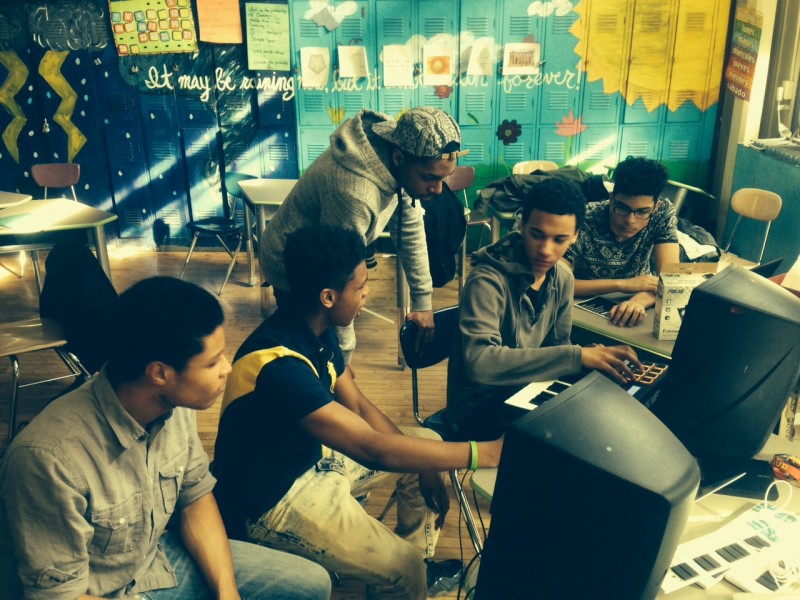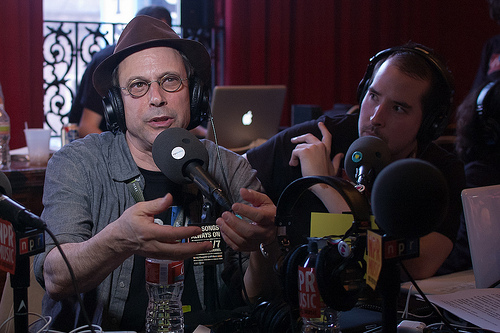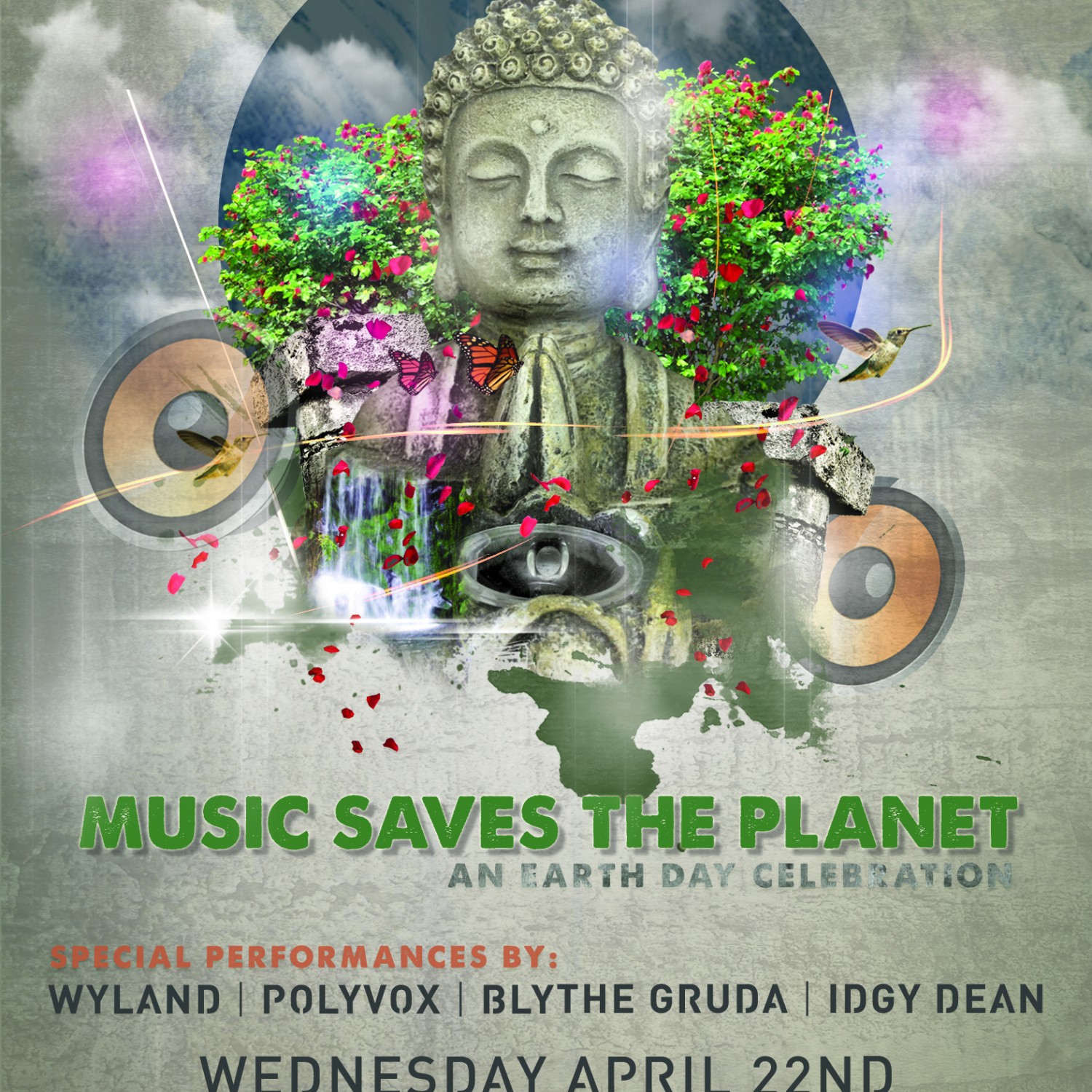- 9 years ago
-
Radio has made a strange sort-of come back. Streaming services, apps, iTunes and the seemingly endless potential of the internet has helped radio transition rather gracefully into the digital age. You can still turn on a radio, flip to a certain channel and find stations, but it’s the ability or perhaps the willingness to adapt that has helped bring the other older model radio shows into the future. They have been joined by countless podcast and live streams all of which are as accessible as wifi.
One thing hasn’t changed. Whether a show is being beamed to you through your car stereo or through your phone via your Stitcher account, there’s still one common factor: sound. Radio is still something you just listen to. It hasn’t added another sense or dimension. You just listen. The same way you just listen to an album. It’s a simple interaction, but can leave such an impression. A good song can make you cry, laugh or turn off your iPod. The same goes for radio. Here are a couple good shows worth a listen:
+1
Hosts of NPR’s All Songs Considered Bob Boilen and Robin Hilton also record smaller segments, the most recent being about Record Store Day. They two covered what releases to keep an eye out for. Their longest, more regular series All Songs Considered is also worth checking out. It’s a good resource when trying to sort of the week’s essential listens.The Mike Herrera Hour
Idobi Radio airs a segment of MXPX’s Mike Herrera podcast, The Mike Herrera Podcast, on Fridays at 20:00 ET. The shortened version, known as The Mike Herrera Hour, is the first hour of Herrera’s show, but features the same mix of conversation. Tune in to hear a seasoned and well-respected musician discuss culture, tech, travel politics and of course music. With its refreshingly frank manner, there’s no way Herrera’s radio presence will go the way of the buffalo.Hi My Name Is Mark
Blink-182 bassist Mark Hoppus hosts this podcast somewhat infrequently, but installments are always worth the wait. Hoppus started recording and posting episodes of “just music and thoughts and whatever” when the band was on hiatus and has continued much to the delight of both Blink and radio fans. The HMNIM podcast has since grown in followers, who now gather around their speakers await the answers to life’s important questions, like “What the hell is a Matt Skiba?”Full Frontal
Sideshow’s Full Frontal features pop punk band All Time Low’s vocalist/guitarist Alex Gaskarth and Jack guitarist Barakat. Known for their crude humor and rather imaginative conversations, the two musicians have hosted Full Frontal for several seasons now. Taping from the back of their tour bus or really wherever they can set up, the two banter openly and honestly in a way that makes you feel like you’re talking to friends… albeit somewhat immature friends. Their most recent installment just kicked off their fourth season and features news about the band’s must recent album Future Hearts as well as other musings.
Latest News
- 9 years ago
-
Barcelona-born Brooklynite, pianist Eva Novoa has produced two cds, her debut Trio (with Masa Kamaguchi on bass and Marc Lohr on drums), and Quartet (with Ernesto Aurignac on alto saxophone, Masa Kamaguchi on bass and André Sumelius on drums), both released on the label Fresh Sound New Talent. Before moving to Brooklyn, she lived many years The Hague, Netherlands, studying, and eventually teaching at Koninklijk Conservatorium.It was in Holland, that she not only learned Dutch curse words, she also how to live in shitty weather: “It’s much worse than New York. It may rain 6 days out of 7, she says while chatting in her kitchen, over espresso and Spanish shortbread cookies. “Wherever you go, you’re soaked, shoes are dripping water.”
 Find out about her beloved fashion accessories after the jump, and learn more about this gifted musician at EvaNovoa.com.Jacqueline Colette Prosper, @yummicocoRead More
Find out about her beloved fashion accessories after the jump, and learn more about this gifted musician at EvaNovoa.com.Jacqueline Colette Prosper, @yummicocoRead More- 9 years ago
-
NYC non-profit Art for Progress hosts this special event Wednesday, April 22nd at The Bowery Electric to celebrate Earth Day and to raise awareness. The night will feature an outstanding line up of artists with local pop rockers Wyland headlining the night. The amazing Blythe Gruda will open the show and feature some very special guests followed by a one woman psychedelic rock performance from Brooklyn’s Idgy Dean. Indie rockers Polyvox will close out the night with a set of synth driven beats. Tickets are $10 and include the chance to win amazing door prizes from Gibson Guitars and tickets to The Museum of Natural History.
- 9 years ago
-

Teaching beat making and digital music production is always as much of a learning experience for me as it is an opportunity to share my techniques and skills with my students. This semester at the James Baldwin School, I have been working with a great group of kids with a very eclectic set of sensibilities. Some already have experience using Fruity Loops, FL Studio, Ableton or other production software on their laptops and tablets at home to make beats or tracks. Some are completely new to the process music making. Still others have experience playing traditional analog instruments, and are interested in expanding their musical palettes. The key guiding principle for me as I work to guide each student toward their own personal music making goals is to instill in them an ethic of making music from intention. By this I don’t mean that that they need to decide in advance what their music means, or what experience the end listener will eventually have; although that is another, very interesting conversation. I simply mean that I encourage them to develop the skill of hearing the music in their heads, and having a vision of the ultimate result before setting ideas down. This is especially challenging at the present moment, because many production tools, and especially software based production methods enable us to bypass that step by using pre-existing loops and samples, and automatically time syncing them. Some even put them in tune with one another. While this allows for a neophyte to quickly garner immediate gratification, which can be confidence building; it allows also for a complete disconnect between what we set out to accomplish and where we arrive.
These days it is increasingly easier to arrive at a final result that sounds like “professional” work. Many of the pitfalls that music makers of past decades needed to learn to avoid through experience are automatically eliminated by more and more sophisticated software solutions. This might sound very helpful, and like it removes obstacles to create an easier path to creativity. While this is not entirely untrue, the trade off is that someone working in this way without basic musical knowledge is limited to using sounds and phrases that are created by others, and often don’t develop the skill of generating the sounds they conceive of themselves. They end up approximating, at best, what they originally intend, and are often sidetracked completely. They become dependent upon loop libraries and specific software in order to create music. The final product is often a compromise, and not what they might have created if they had the tools and skills to translate their own ideas directly into music. While even this methodology can be mastered and manipulated by the most diligent practitioners, most new users are wooed by the easy payoff and neglect to learn the most basic musical skills. An analogy would be learning to fly an airplane before learning to walk. While long distance flight is a useful skill, it would be difficult to get around once you landed anywhere.
In response to this dynamic, while I don’t discourage my students from applying any effective method to arrive at their ultimate goal, I do caution them about getting “lost in the box”, a phenomenon that happens when using technology without a clear goal. The danger is that there are so many choices of sounds and phrases, that it’s easy to lose sight of the original vision for a song or a track, and to get caught up, and ultimately overwhelmed and never arrive at a finished version of the work. If they do finish work, it often bears no resemblance to what music they were originally motivated to make. I instead work to instill in them a reverence for basic musicality, teaching them the mechanics of rhythm, harmony and melody both before we engage with the technology, and continually reiterating throughout the production process how the elements are present. It’s a modern application of the old adage “Give a man a fish, and he’ll eat for a day. Teach a man to fish, and he’ll eat for a lifetime.” Regardless of the instrument, technology, interface, or work style; fundamental musical skills provide the strongest foundation for creating music of any genre.
As a guitar player and teacher, I often suggest to students that they sing every note they are playing on the instrument in order to “keep themselves honest.” This approach requires a guitarist, or any melodic player to first know the note they mean to play, otherwise the note they sing and the note they play will not match. The level of focus and skill this technique demands of the user seems to be alien to many of my production students. The interface of digital instruments is often not applied as directly as that of an analog instrument, but it certainly can be.
Embracing this type of ethic cultivates a respect for, and helps develop a fundamental understanding of any topic. With that understanding, students begin on their own to desire to glean the basic skills of their craft. For my students, it also helps to peak their interest in music, and technologies that came before them, helping them see themselves as torch-bearers of a great legacy. I had the wonderful opportunity to meet the great musician and inventor Les Paul a few years back, and to hear him play. He was in his ’90’s at the time, and while many people are familiar with the guitars that bear his name, his lesser known accomplishments have shaped the way we all hear and create music today. As the inventor of the solid-body electric guitar, reverb, and multi-track recording, he created recordings that at the time sounded as though they were from another dimension. While on stage, he mentioned that, since he was the inventor of modern recording technology, many people ask him what advice he would pass on to emerging artists and young people getting into music making and production now. His response was priceless, and illustrates most clearly my modus operandi as I pass my own knowledge and experience to my students. He said, simply, “Figure out what you want to play before you turn the machine on.”
I took this to heart, and ask my students to first listen for music inside of themselves, and to see whatever tools they use as a means to get that music out of their minds and into the ears of the world.
- 9 years ago
-
I am sometimes asked to describe my music teaching methodology. Having done this frequently, I have distilled my basic philosophy to a few key themes, which accentuate the contrast between how I approach music education with Art for Progress, and how music is traditionally taught in public schools. There are clear differences in goals, in repertoire, and in what information is considered important to convey.
First, the goals are different at their essence. Traditional music instruction involves learning the mechanics of an instrument and the written language of music notation in order to reproduce pieces of music that have earned their place in the vocabulary of music educators, often, though not always, centuries or decades ago. There is little explanation of the relationships between the elements of music, or consideration of building skills toward creating original music. Traditionally trained players are often discouraged from improvising, and develop an aversion to it and even a fear of hitting wrong notes if they dare explore uncharted territory.
On the other hand, many untrained musicians, often referred to as self-taught, are undeterred by the pitfalls of exploration because they know it to be the path toward discovery. These include many folk, blues, rock, reggae, indie, pop and hip-hop musicians. Rather than learning music note for note from transcriptions, they develop a modular understanding of chords, scales, and riffs, which enables them to reproduce the primary elements of pieces they learn by simply hearing them. These musicians sometimes do not even read music notation, and yet are able to compose and share the music they make up with others. They use a spoken vocabulary unique to musicians that describes the mechanics of music differently from notation. This vocabulary often conveys information about parameters that are not described by or even addressed by traditional written music. These parameters include feel, groove, the nuances of articulations like bends, slides, hammer-ons, and pull-offs, and subtle dynamics that are too specific and singular to notate.
These days, new musicians have an unprecedented number of resources at their disposal, and a nearly equal number of attitudes and philosophies about the best way to learn. In my opinion, any student should avail him or herself of any and all methods and technologies, but it can be hard to prioritize, or even to know what is effective when one is inexperienced.
I think it is equally important to learn the mechanics of your instrument or instruments, music notation, basic theory, the spoken vocabulary of musicians, a varied repertoire, and to listen attentively to examples of great music of all kinds. That may seem like a lot, but good musicians can benefit from all of these ways of looking at music. When you approach all of these subjects organically, you can see them as one integrated path. It becomes less important what is explored in what order, and more important that there is a fully engaged experience happening. Once a student can be encouraged to persevere through the fact that any aspect of learning that is of any value is going to be challenging and frustrating; he or she usually starts to develop enthusiasm on his or her own.
In order to be a capable musician, or just to get the most out of being a learning musician, it is also worthwhile to study the inner workings of the musical language. Unfortunately, this is all but ignored except at the highest levels of the established music education system. Only jazz students, who have already technically mastered their instruments, are encouraged to understand the relationships inherent in western diatonic music, or the 12-tone system. Clearly, new musicians do not need to understand all of the implications and nuances of modern jazz theory, but a working knowledge of the primary factors at hand can help any musician.
There are conventions and recurring themes, especially in modern popular music that can be grasped using a methodical approach, and observing exemplary pieces. A working understanding of these conventions, which include: tension and release, movement around the cycle of 4ths/5ths, scales, the common uses of intervals, frequently encountered chord progressions, and song form, can demystify the elements of a song in short order. They can therefore pave the path for a new musician to play a familiar song in a short time. This almost always results in a huge confidence boost, in addition to the satisfaction and sheer joy of being able to reproduce the piece.
When I was growing up, I was asked to choose an instrument in elementary school. I chose alto saxophone, and had band class in school, as well as individual lessons from the music teacher, Mr. Lulewicsz. I was not particularly diligent, and stopped playing after a couple of years. Despite taking piano lessons for a few years after, I had pretty much given up on being a musician before high school started. I find this to be the case with many of my students. I think for me, it was that I was never encouraged to learn music that interested me, or to play with others informally and experiment.
Those are the key elements of my personal style of teaching music. I explain to my classes that my goal for them is to be able to play any song they want learn, within reason. I then begin to break down for them the elements that make up all pieces of music, including rhythm, melody and harmony. We spend about a month taking a brief look at the ways in which those systems work, all the while including familiar examples in order to illustrate the relevance of each topic explored. We also look at how the information translates to the layouts of the piano and of the guitar, and I illustrate how certain musical concepts are organized on those instruments. By the time students get onto instruments and start learning songs, usually in small groups or individually, everyone has at least some familiarity with the language, and can build upon that first exposure as they put things together.
Working with small groups, or taking the time to focus with one student at a time for a good portion of a class period enables me to tailor my approach to the learning style that works best for each student. While I can’t spent time with everyone individually every day, if I get the ball rolling with one student or group one day, I can work with another student or small group the following day while the initial group works on perfecting the task they learned the day before. As the class gradually builds the skills to learn the first songs they tackle, the basic concepts begin to sink in, and set the stage for playing with others. In fact, some days I’ll just abandon repertoire altogether and give everyone in the class a simple role on an instrument and focus only on playing rhythmically together.
In a very short time, with simple tools, music students turn into beginning musicians, who turn into capable players and singers before they realize they are actually learning in school.
Pretty sneaky, huh?



